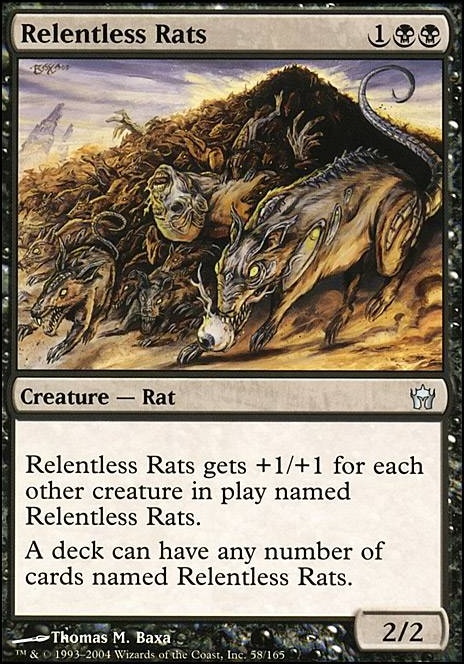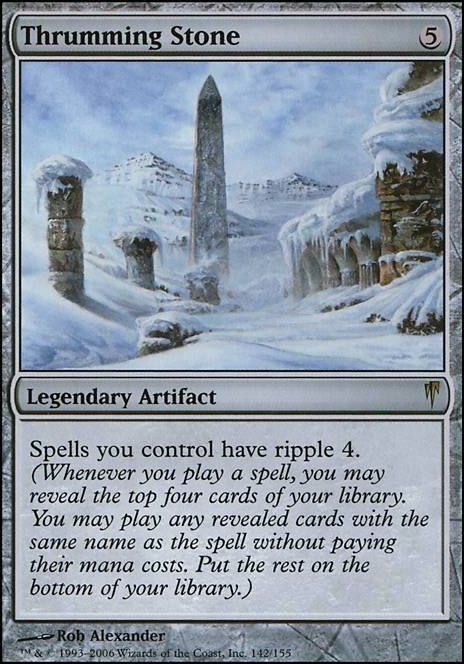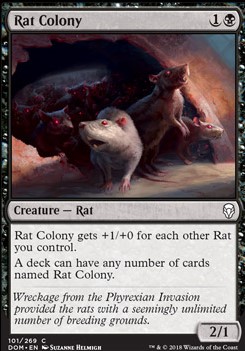Pattern Recognition #297 - Relentless
Features Opinion Pattern Recognition
berryjon
14 September 2023
542 views
14 September 2023
542 views
Good day everyone! My name is berryjon, and I welcome you all to Pattern Recognition, TappedOut's longest running article series. I am something of an Old Fogey and a definite Smart Ass, and I have been around the block quite a few times. My experience is quite broad and deep, and so I use this series to try and bring some of that to you. Be it deck design, card construction, mechanics or in-universe characters and the history of the game. Or whatever happens to catch my attention each week. Which happens far more often than I care to admit. Please, feel free to talk about my subject matter in the comments at the bottom of the page, add suggestions or just plain correct me.
And so, welcome back! I hope every is enjoying the weather outside, I know I sure am! But, sadly, we must turn our attention away from the great outdoors, and back towards Magic. Today's subject came about because I was rolling Historical Brawl on Arena, and came across a lovely deck that was running Rat Colony. Fortunately, my Firesong and Sunspeaker deck can deal with that with ease, and it was a match I won. Or rather, they quit after they realized they would be lucky to ever have more than two Rats out at a time. But with that victory fresh in my mind, I wondered to myself, what had they done wrong? What had they done right?
And what did this card do, to cause such a fuss?

Behold, the creature that created an archetype.
So, what makes a card Relentless? Well, first, nothing. Or rather, the phrase Relentless is not a Keyword. It is a casual reference to the text on a card that reads "A deck can have any number of cards named $CARDNAME." This allows this card to bypass the 4-of restriction for all non basic lands in those formats, or the 1-of restriction in EDH and variants. The specific text on the creature in this case overrides the general rule of the game. And while the ability is openly referred to by everyone from the playerbase to Mark Rosewater, it will probably never be Keyworded properly, as Keywording usually entails being printed multiple times in a set to help solidify its use as a set mechanic. Instead, this is something that shows up once in a while, makes a splash, and fades away.
In fact, there are only five really Relentless cards in the game, with two honourable mentions. Dragon's Approach, Persistent Petitioners, Rat Colony, Relentless Rats itself, and Shadowborn Apostle are all truly Relentless, while Nazgul and Seven Dwarves can break the per-card limit of the format, but have their own intrinsic limits.
But let's get back to the Original for a little bit, shall we?
Published in 5th Dawn, this card had the distinction of being one of the less broken cards in the set, thanks to being in the Mirrordin Block. Not being an artifact was already in its favor, but at the time - in Standard at least - it was seen as something of a gimmick build for the format, Tier 2 at the best.
Waits for the inevitable comment in the comments below about how this totally won tournaments.
Well, anyway, there were two things about the Rats that made them stand out. No, not the Relentless part. Rather, they had a benefit and a drawback, and balancing the two was a precarious act that often didn't quite work in the long run. The benefit, the one thing that made the Rats far more effective than they should have been, was their geometric growth. The first one was a simple 2/2. However, the second one turned them both into 3/3's. The third made you have 3 4/4's, and so on and so forth.
You see, linear growth is something we're all familiar with when we play things like tokens. We add more of something, and the improvement on our board state is directly commiserate with the amount of new pieces we have in play. Add three Goblin tokens to the battlefield, and you have three more 1/1's. Geometric Growth not only adds new pieces to the battlefield, but each piece improves each other piece mutually, making everything better in the process.
This is exaclty how Slivers work, mind you.
But because the Rats grew Geometrically with each creature on the table, and they did so without having key weaknesses like the Slivers, they could, in theory, overwhelm the opponent with a large board state and out-value over time.
Which leads into the other problem. The Rats were slow. With a base cost of , even in the best of circumstances in the Standard of the time, you would cast this creature on Turn 3, and swing with it as a 3/3 on turn 4 with a second Rats on the table with Summoning Sickness. I don't know about you, but in Mirrordin Standard, a 3/3 on Turn 4 was losing. And because of this, the Rats were relegated to a side-show to the real power in the set.
The following Block, Kamigawa, gave the Rats a shot in the arm, though not in the way that was a proper synergy with the Rats directly. In that block, there were 15 Rats - Nezumi properly - that now shared a Standard Rotation with the Relentless Rats. What we had then was a curious mono- deck for that Standard that utilized the Rats, and the Ninjitsu mechanic to play some games with combat, all to attack the opponent's hand size. After all, a player with no cards can't play, right?
What I saw at that time was that the Relentless Rats found a home in this deck archetype as a way to close out the game. I played against decks that went Gnat Miser, Kuro's Taken, Relentless Rats, and then slowly advanced their game state while keeping up slowly building their Rats until they could safely resolve Marrow-Gnawer and swing with their Rats for the win. In effect, a Control deck that used the Rats as their face-smashing win condition.
Sadly, the Rats faded out after this point. They were something of a meme deck, and would occasionally see someone pull a deck like this out in Extended or the like as something of a rogue deck that people weren't really prepared for because it wasn't meta.
Things changed with the release of set that wasn't in rotation, but was part of Standard because it was a taste of things to come with Time Spiral. Coldsnap was a throwback to the Ice Age non-Block, and a way to 'fill in the gap', so to speak with the missing third set in the block. It was a precursor to the more modern things like the Lord of the Rings sets, and things like that, but that's a tale for another day.
But in Coldsnap, there was a mechanic called Ripple N. This ability read "When you cast this spell, reveal the top N cards of your library. You may play any cards that share a name with this card without paying their mana cost, then put the rest on the bottom of your library." This card appeared on five commons, one for each color, and the most under-appreciated card that I ever saw:

Thrumming Stone was the key to bringing Rats back, and bring them back with a vengeance. You see, the major weakness of Ripple was how it was fixed to a 4 in all cases (and probably won't be changed or see the light of a Standard set again) and because you had to go find a card with the same name...? Well, how often would that trigger in reality? Once or twice, maybe? Not in the same casting, I can assure you. And it was a wash in Limited as well, as while the deck size was reduced to 40, getting the Stone out, then casting something that you might not have multiple copies of in the deck, or only have 2 or 3? The odds were ... low.
But what if you had 20 cards by that name in your 60 card deck? What if you could statistically guarentee that when you cast a spell, there was at least one more copy in the next four cards in your deck? And then, because Ripple is just a casting trigger, you can then Ripple off your Rippled spell?
Suddenly, Ripple Rats was a threat. Accelerate to 5, hit the Stone, then flip your entire deck of Rats out onto the board. Add removal and control to Taste, and swing for the win with just one or two Rats. Who cares about Summoning Sickness on all of them if they're just there to make your unsick Rats bigger?
And with that, the Rats deck went from meme to viable, and it's stayed that way in most formats ever since. However, the story doesn't end there.
First printed in M14, Shadowborn Apostle was the second Relentless card in the game. This creature wasn't like the Rats in how they got bigger and badder the more there were, but rather they acted in a group of six creatures to fetch a Demon out of your library and into play. I just checked, and the only Demon in Magic 2014 was Shadowborn Demon ... which isn't really good. I mean, yes, it's removal, and a very big creature for its cost, but there are better. And to be fair, the Apostle wasn't designed for Standard. Well, it was, but not really.
No, Apostle was designed for larger formats. Wizards had noticed how the Rats worked, and the Apostle was a very careful experiment in how they could do it for Modern, Legacy, and even that new-fangled format that was all the rage - Commander. And to that end, it worked. Apostle Decks may not be utter powerhouses, but they perform solidly in all relevant formats, and are still seen to this day.
I have never played an Apostle deck, so I can't really comment much more about it, except to recognize its persistence in existence, a pun which will come back to haunt me shortly.
Moving on, we come to Dominaria. In a set that was a deliberate throwback to Magic's great hits, and amazing cards (and some not-so-amazing ones), we were given Relentless Rats true successor.

Rat Colony is, in pretty much all ways but 1, better than Relentless Rats. First is that Rat Colony counts all Rats you control, not just other Rats with the same name. So if you're going to go back to Marrow-Gnawer and toss him into a deck with these rats, not only to they count that Legendary Rat for their boon, but they also count the tokens he makes for the same. Thus, a Rat Colony deck can quickly achieve higher Power for their creatures for less effort than their Relentless version. Second, and perhaps more importantly, they are cheaper. At only , that lack of a third mana makes them far more viable as an aggressive creature type, as being able to double-cast them on turn 4 to swing out with what you already have is far more effective than waiting until turn 6 to do the same.
In fact, it is this deck that I destroyed that caused me to work on this article. Because you see, the Colony has one single, vital flaw in it that makes it very fragile. Something of a glass cannon you might say.
They only have 1 Toughness. Unlike the Relentless, which starts at 2 and gets bigger with each other Relentless, the Colony is stuck at 1 toughness the whole time. And against a burn deck that runs things like End the Festivities, they're far to easy to kill before they reach critical mass.
Which isn't to say they're weak. They're not. They're a more efficient version of their predecessor, and should still be respected for it.
From there, Wizards moved on and experimented with moving Relentless out of and into with Persistent Petitioners - and the payoff for that pun earlier.
This creature focused on Mill, and while individually, they were quite bad at it, once you reached the magic number of 4, they became quite good. There was some efforts to make them work in Standard, but War of the Spark shifted the meta enough that the Petitioners quickly fell out of favor in Standard. Yes, they were still around, and you had to be prepared for them. That, and they were basically a setup for the in-development Bruvac the Grandiloquent, which is a potent Commander on paper.
Which I suppose allows me to lead into a secondary effect of the Relentless mechanic. Each individual creature that is Relentless is something in of themselves, but they support each other and the whole is greater than the sum of the parts.
Which leads us into the last real Relentless card - Dragon's Approach. This card allows you to burn your opponents with each casting, and after the fifth one, you can then exile the casted one and four from your graveyard to search for a Dragon out of your library. Then (more) bad things can happen to your opponents!
Dragon's Approach is definitely a very take on the Apostle decks of yore, and it definitely works, given how much that card drove Strixhaven sales at my LGS. It may not be a 'classic' Relentless card, but it works well enough for me to count it.
As for the honorable mentions, well, the Nazgul are too new for me to really have a grasp on, and they are tied to the Ring-Bearer mechanic pretty heavily, so I can't have an opinion about them. On the other hand, Seven Dwarves is a card I don't really remember seeing outside of ... Uh... Magda, Brazen Outlaw Brawl/Historic Brawl/Commander decks? They existed, but they don't have any presence in my mind.
If anyone has any thoughts about them, please share in the comments below and make yourselves heard!
Anyway, Relentless is a neat thing, one that I'm glad is a tool that Wizards rarely touches on the grounds that while I can appreciate the importance of consistency in a deck, there is such a thing as too much of a good thing. In addition, a Relentless deck is very much a one-trick pony, and if you can cut that down at the knees before it gets going, they can't really recover.
Give it a shot! I encourage it. It's an interesting thing to break out every once in a while, and it helps keep your opponents on their toes. And you on yours if someone rolls it out against you!
Tell me about your experiences with the Relentless spells, and share with the class!
Thank you all for joining me this week. I'll see you next week for something new. What it is, I don't know yet. I take suggestions!
Until then please consider donating to my Pattern Recognition Patreon. Yeah, I have a job, but more income is always better. I still have plans to do a audio Pattern Recognition at some point, or perhaps a Twitch stream. And you can bribe your way to the front of the line to have your questions, comments and observations answered!